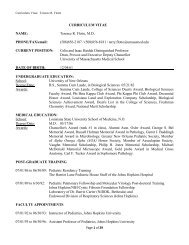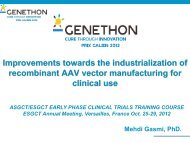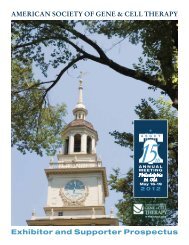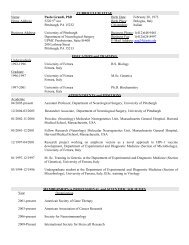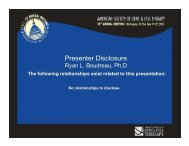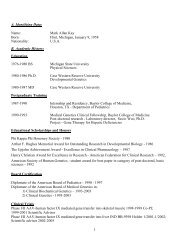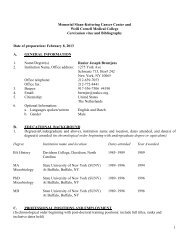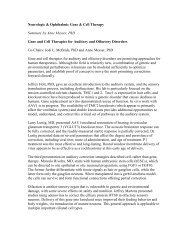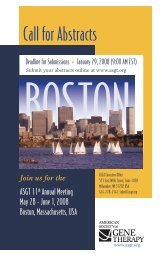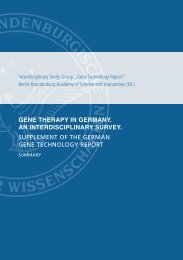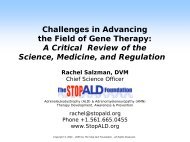Final Program - American Society of Gene & Cell Therapy
Final Program - American Society of Gene & Cell Therapy
Final Program - American Society of Gene & Cell Therapy
You also want an ePaper? Increase the reach of your titles
YUMPU automatically turns print PDFs into web optimized ePapers that Google loves.
<strong>Program</strong> Schedule, Wednesday, May 15, 2013<br />
Wednesday, May 15, 2013<br />
Education Session 124<br />
1:15 pm - 2:45 pm<br />
ROOM: 150 ABC<br />
Topical Review: Synthetic <strong>Gene</strong> Delivery<br />
An overview <strong>of</strong> different philosophies <strong>of</strong> synthetic delivery systems for nucleic acids. The irst talk will address silk elastin-like proteins for<br />
gene delivery and how they can be combined with virus for an enhanced hybrid gene delivery vehicle. The second talk will focus on “smart”<br />
pH-sensitive polymeric carriers for therapeutic delivery <strong>of</strong> nucleic acids. The inal talk will examine cell-penetrating peptides for retinal gene<br />
delivery.<br />
CHAIR: James Yockman, PhD<br />
SPEAKERS<br />
Hamid Ghandehari, PhD<br />
Recombinant Polymers for <strong>Gene</strong> Delivery<br />
Polymeric systems have shown utility in gene delivery. They can form complexes with nucleic acids or be used as matrices for<br />
controlled release. Majority <strong>of</strong> polymers used for such purposes are synthesized by chemical strategies that result in limited control<br />
over polymer structure and therefore function. Recombinant polymers provide exquisite control over backbone structure. This talk<br />
will summarize the use <strong>of</strong> recombinant polymers for gene delivery applications.<br />
You Han Bae, PhD<br />
pH-Sensitive Polymeric Carrier for Nucleic Acid Delivery<br />
The journey <strong>of</strong> a gene carrier from an administration site to target individual cells encounters a series <strong>of</strong> formidable barriers in<br />
the blood compartment, when crossing vascular walls, and while penetrating extracellular matrix. <strong>Cell</strong> uptake and intracellular<br />
traficking steps then follow, which have been major foci in carrier development and in vitro tests. The carrier may require<br />
switching surface property depending on environmental conditions during the voyage for higher probability <strong>of</strong> reaching its target<br />
cell and action site. The potential roles <strong>of</strong> pH-responsive polymers, particularly weakly anionic polysulfonamide and cationic<br />
poly(L-histidine), in this challenging journey will be discussed.<br />
Rajendra Kumar-Singh, PhD<br />
Pegylated Peptide-DNA Nanoparticles Delay the Onset <strong>of</strong> Retinal Degeneration in Mouse Models <strong>of</strong> Retinitis<br />
Pigmentosa<br />
We have developed a novel peptide referred to as ‘Peptide for Ocular Delivery’ or POD that can penetrate cells and tissues in vivo<br />
within 5 minutes. When pegylated, POD can compact DNA and enable marker or therapeutic gene delivery to retina in vivo. These<br />
nanoparticles are approximately 150 nm in size and can enable therapeutic transgene expression in vivo for more than 70 days.<br />
POD-DNA nanoparticles can reduce apoptosis and delay retinal degeneration in a mouse model <strong>of</strong> retinitis pigmentosa. POD has<br />
potential therapeutic applications in ocular as well as non ocular organ systems.<br />
Education Session 125<br />
1:15 pm - 2:45 pm<br />
ROOM: 151 ABCG<br />
Topical Review: The Ins and Outs <strong>of</strong> Integration Deicient Lentiviral Vectors (IDLV’s)<br />
The Ins and Outs <strong>of</strong> Integration Deicient Lentiviral Vectors (IDLV’s)”, will focus on the development and utilization <strong>of</strong> IDLV’s in preclinical<br />
trials. The session comprises three presentations. The irst is an introductory presentation, which will concentrate on the molecular<br />
mechanisms involved in the production and regulation <strong>of</strong> gene expression from IDLV’s. The second presentation will focus on illegitimate<br />
integration <strong>of</strong> IDLV’s, and the third presentation will describe the development <strong>of</strong> a novel IDLV system for cancer immunotherapy.<br />
CHAIR: Tal Kafri, MD, PhD<br />
SPEAKERS<br />
Tal Kafri, MD, PhD<br />
The Basics <strong>of</strong> Integration Defective Lentiviral Vectors<br />
This introductory presentation will focus on the molecular mechanism involved in the generation <strong>of</strong> integration defective lentiviral<br />
vectors (IDLV’s) and the molecular assays employed to determine the eficacy and safety <strong>of</strong> the currently used IDLV gene delivery<br />
systems. In addition the presentation will outline advancement in IDLV design, which improve IDLV gene expression and reduce<br />
illegitimate integration.<br />
42<br />
<strong>Final</strong> <strong>Program</strong> SALT LAKE CITY, UTAH May 15–18, 2013



